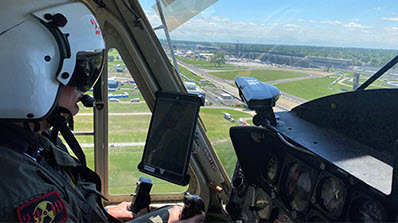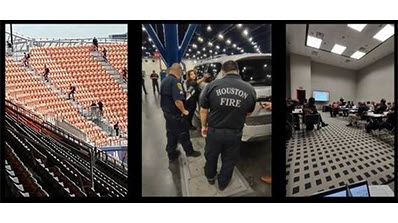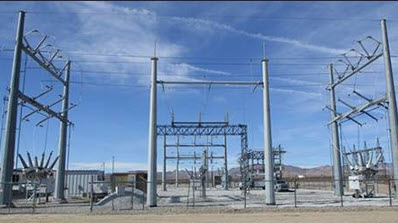*The NNSS’ FY22 runs from Oct. 1, 2021 through Sept. 30, 2022
Substation upgrade
In December of 2021, the NNSS completed several important upgrades to the Frenchman Flat Substation, improving power system reliability in support of mission work, progressing the broader NNSS power modernization strategy, and greatly extending substation operation.
The completion milestone was achieved two weeks ahead of schedule and under budget, enabled by application of the NNSS Project Delivery Initiative, which is driving improvements to project development and execution across the NNSS. Successful execution of the project was specifically identified as a critical commitment on NNSA’s NA-50 Office of Safety, Infrastructure, and Operations (now the NA-90 Office of Infrastructure) FY22 Make It Happen List.
These improvements will greatly extend substation operation, improve reliability of our power system to support missions, and progress the broader NNSS power modernization strategy.
Record safety performance
Despite challenges associated with oscillating pandemic conditions and expanding NNSS work, the NNSS’ management and operating contractor, Mission Support and Test Services (MSTS), ended FY22 Sept. 30 with a record safety performance: a TRIR [total recordable incident rate] of 0.35 and a DART [days away, restricted or transferred] rate of 0.08. These rates are well below the average 2021 NNSA TRIR of 1.2 and DART rate of 0.66. Additionally, the MSTS DART rate is at an all-time low for the life of the contract and the past 13 years of the NNSS.
Level 2 Milestones
The NNSS in FY22 completed 24 Level 2 Milestones—important or critical events and/or activities that must occur in a project cycle to achieve the project objective(s).
Protecting the public

The NNSS’ Remote Sensing Laboratory aided in protecting the public through aerial and ground radiological monitoring during 10 events garnering national attention:
- Las Vegas New Year’s Eve
- Rose Bowl
- Super Bowl LVI
- State of the Union Address
- Boston Marathon
- Washington, D.C. Independence Day Festivities
- 9th Summit of the Americas
- Indianapolis 500
- World Games
- United Nations General Assembly
The leadership, operational support and data analyses the NNSS provides for these events keep the nation safe from potential radiological events and provide critical subject matter expertise and continuity for National Nuclear Security Administration Nuclear Emergency Support Team (NEST) missions.
Diversity & Inclusion
The NNSS’ seven affinity groups focused on awareness, recruitment, retention, networking and mentorship, with an emphasis on science, technology, engineering and math (STEM) outreach and workforce inclusiveness.
Site-Directed Research and Development
NNSS’ SDRD program funded 39 exploratory research projects and 16 feasibility studies. The team also published 30 journal publications.
Counter Terrorism Operations Support (CTOS)

NNSS’ CTOS program in FY22 trained 13,647 first responders, for an all-time total of 286,746 certificates. CTOS develops and delivers training for emergency responders to take immediate, decisive action to respond to terrorist use of radiological or nuclear weapons of mass destruction, such as radiological dispersal devices and improvised nuclear devices.
Environmental management
The NNSS securely disposed more than 635,000 cubic feet of classified and low-level/mixed low-level waste, transported to the NNSS in 791 shipments. This critical disposal capability supports DOE cleanup and other activities at federal sites across the U.S. involved in nuclear research, development and testing, and ongoing national security and science missions. During FY22, the NNSS waste acceptance review team increased onsite facility evaluations, extensive profile verifications, and radiography to validate that the waste received for disposal is consistent with the characteristics (radiological and chemical composition) in the approved profile. These efforts also fulfill commitments made to the State of Nevada.
STEM and community sponsorships, support
Throughout FY22, the NNSS donated $696,000 in the following areas: universities ($308,000), K-12 science, technology, engineering and math (STEM) organizations ($225,000) and community organizations ($163,000). Additionally, 247 NNSS volunteers donated 915 hours over the course of 10 community events, while 75 NNSS Fire & Rescue volunteers donated an additional 1,300 hours over the course of 11 community events. And finally, 77 NNSS volunteers donated 465 hours over the course of 18 STEM events.
Tours and visits
The NNSS hosted a total of 105 tours and visits in FY22. After tours and visits were paused during the COVID-19 pandemic, the NNSS hosted its first tour of the year on Feb. 23. U.S. Rep. Susie Lee and her staff learned about the NNSS’ programs, research and development work, and role in the U.S. national security mission.
The NNSS welcomed several other high-level visitors throughout 2022, including NNSA Administrator Jill Hruby, DOE Secretary of Energy Jennifer Granholm and many more.
Starting July 20, the NNSS also began hosting public tours again. Public tours were first offered to the backlog of more than 750 people who had been scheduled to attend 2020 tours that were canceled due to the COVID-19 pandemic. Tours were then opened to new sign-ups Aug. 29, with all available slots filling up in fewer than five hours.
